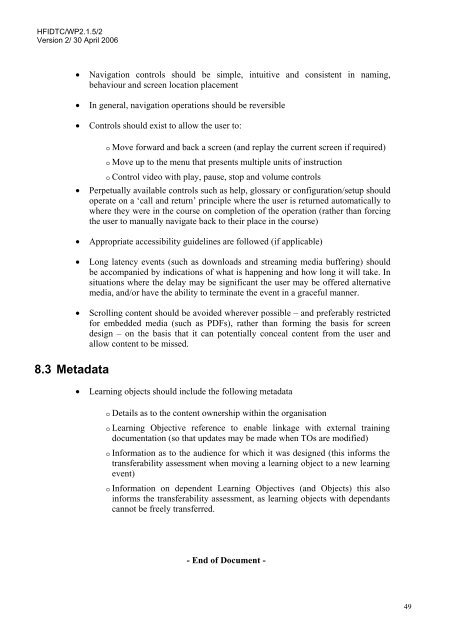E-learning Instructional Design Guidelines - Human Factors ...
E-learning Instructional Design Guidelines - Human Factors ...
E-learning Instructional Design Guidelines - Human Factors ...
Create successful ePaper yourself
Turn your PDF publications into a flip-book with our unique Google optimized e-Paper software.
HFIDTC/WP2.1.5/2<br />
Version 2/ 30 April 2006<br />
8.3 Metadata<br />
• Navigation controls should be simple, intuitive and consistent in naming,<br />
behaviour and screen location placement<br />
• In general, navigation operations should be reversible<br />
• Controls should exist to allow the user to:<br />
o Move forward and back a screen (and replay the current screen if required)<br />
o Move up to the menu that presents multiple units of instruction<br />
o Control video with play, pause, stop and volume controls<br />
• Perpetually available controls such as help, glossary or configuration/setup should<br />
operate on a ‘call and return’ principle where the user is returned automatically to<br />
where they were in the course on completion of the operation (rather than forcing<br />
the user to manually navigate back to their place in the course)<br />
• Appropriate accessibility guidelines are followed (if applicable)<br />
• Long latency events (such as downloads and streaming media buffering) should<br />
be accompanied by indications of what is happening and how long it will take. In<br />
situations where the delay may be significant the user may be offered alternative<br />
media, and/or have the ability to terminate the event in a graceful manner.<br />
• Scrolling content should be avoided wherever possible – and preferably restricted<br />
for embedded media (such as PDFs), rather than forming the basis for screen<br />
design – on the basis that it can potentially conceal content from the user and<br />
allow content to be missed.<br />
• Learning objects should include the following metadata<br />
o Details as to the content ownership within the organisation<br />
o Learning Objective reference to enable linkage with external training<br />
documentation (so that updates may be made when TOs are modified)<br />
o Information as to the audience for which it was designed (this informs the<br />
transferability assessment when moving a <strong>learning</strong> object to a new <strong>learning</strong><br />
event)<br />
o Information on dependent Learning Objectives (and Objects) this also<br />
informs the transferability assessment, as <strong>learning</strong> objects with dependants<br />
cannot be freely transferred.<br />
- End of Document -<br />
49
















